As a top digital design and branding agency, Bluetext is familiar with the common client concern, “how can I tell my company’s story with data?”. Recent studies have shown that consumers follow directions and digest information with text and illustration over 300% better than when presented solely with text. It’s true; a picture can tell 1,000 words — and often better. Infographics, statistics, charts, and data visualization design can seem daunting. Whether working with complex or diverse data sets, the design process can often feel overwhelming and messy. Bluetext sat down with our veteran Design Lead, Augusto Pagliarini, to discuss the do’s and don’ts for creating captivating infographics that speak louder than words.
At Bluetext, upon receiving a creative brief, user experience designers dig to research and assess the UX best practices. When designers work with project managers, they like to review research –which is leveraged to show the client examples and directions that might inspire our infographic. This could, for instance, include exploring two options, to see how we can show their data in a multitude of interesting ways.
For research, some of the preferred design resources include Adobe’s Behance, Dribbble, and Pinterest. These websites are great places to discover good layout inspiration and to see what is trending in the design world.
Infographic design is both an art and data science. One of the most important steps in the creative process is wiring and sketching out the infographic, rather than jumping straight into color. Bluetext design best practices start with a sketch to get the client’s reaction. Graphic designers will draw shapes and lines, all with pen and paper. Efficiency is king, it can be a waste of time to create initial sketches in a high-fidelity format such as XD.
Bluetext is a data-driven agency- so our primary focus is looking at the data first, then designing around it. The next step typically involves using Adobe Illustrator, which allows for creating a vector format. These designs allow for infinitely scalable vectors, so our user experience design team can swap out sizes with relative ease.
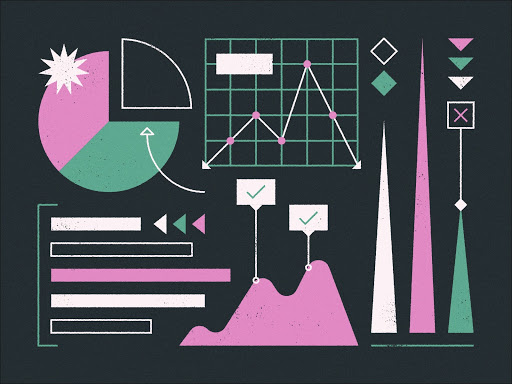
It’s important to know the end-user and the audience. User personas are the base of creative style and direction. Some questions our team considers are should the infographic be playful, or serious in tone? More illustrations, 3D isometric style, or photo-realistic? When it comes to the high fidelity designs, our design team considers if the infographics need to use the client’s branding, working off a set style guide to avoid common pitfalls in infographic design such as using too many fonts and colors. Another key focus is on accessibility– all audiences need to be able to read these items, so a lot of thought is put in at the frontend of the design process to make sure it’s legible, and that the data flows well.
It’s critical to cite your sources and ensure that the design allows for that. This enables our clients to showcase their credibility – whether it be in disclaimer text or link if it is a digital asset.
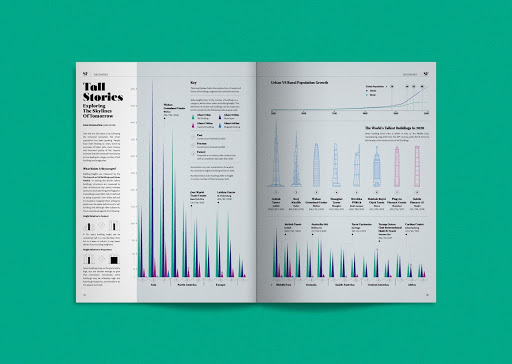
Top Tips to Follow:
- Know your audience and end goal
- Keep design simple
- Show, don’t tell
- Follow style and brand guidelines (where appropriate)
- Do your research!
Faux Pas to Avoid:
- Overcomplicating things
- Designs that are hard to read or follow
- Having no flow or hierarchy
- Hierarchy: In this sense, it is guiding users on what to look at first, what are the supporting points of the infographic, are there too many colors that catch my eye?
- Having no flow or hierarchy
- Too much variety in colors, fonts, and textures
- Too many colors, fonts, and treatments create a lack of uniformity in the entire design. Sticking to a style guide can keep infographics digestible and visually appealing.
Catch the highlights and additional insights in the podcast edition of this post. Just hit play below!
Simplification is one of the strongest trends we’ve seen as a top design agency in recent years. With such growing popularity, it shows no sign of stopping. So why are brands dialing back on designs for a more minimalistic logo? Top graphic design and rebrand experts at Bluetext are debunking this design trend to explain why it’s a wise choice. For one, minimalist logo designs are easily recognizable and memorable, which is key to successful branding. This is why many up and coming companies prefer simplification over other artistic techniques. Similarly, established brands are stripping their logos of excessive details to add more weight to the brand promise. Uber, Yahoo, and Mailchimp have all recently released logos with cleaner, rounded lines to feel more approachable and user friendly.
 Why are these well-known logos going back to basics? We consulted our top graphics designers here at Bluetext, to get their take on the trend. Below are some of the most popular reasons for logo redesigns:
Why are these well-known logos going back to basics? We consulted our top graphics designers here at Bluetext, to get their take on the trend. Below are some of the most popular reasons for logo redesigns:
Complex and Cluttered Digital Environments
With nearly all companies moving to some sort of digital presence, users are constantly bombarded and overwhelmed with content to digest. Embellished logos only add to that already exhausted attention span, requiring time and concentration that people simply don’t have to spare. Cluttered online environments have trained us to scan, filter, and repeat — leaving little bandwidth to notice or appreciate fine detail.
User Consideration
Especially when coupled with features like dark mode, we are seeing brands designing more and more with user experience and comfort in mind. Darker screens and simplified details are easier on the eyes. Reduced eye strain and saved battery life is an added benefit that shows users you care, especially in a pandemic environment where almost all interactions have become virtual and vastly increased average screen time.
Mixed Mediums
Another key consideration for any brand is where your logo will be applied. On your website for sure, but what about printed materials? Perhaps corporate giveaways, like coffee mugs or canvas totes. Logo designs need to accommodate all of these possibilities and easily adapt to any medium. Thus, to save time and resources, companies opt for a clean and crisp logo that they are confident will crisply stand out on any medium and in any size.
Shrinking Screens
It seems every few months or so Apple unveils smaller and smaller iPhone models. And this product design trend isn’t limited to just mobile devices! Laptops, tablets, and even desktops have been consistently shrinking in size as users opt for more streamlined and portable devices. To future proof your brand or website it’s important to consider small screens and how your logo will display. If your design is riddled with lines and textures it may compromise readability on these devices. Instead of reverse engineering your logo to accommodate unique layouts and breakpoints, it’s far more efficient to begin with a simplified, and digitally conscious design.
Botox for B2B
Why do people get Botox? To smooth out those fine lines and wrinkles and look younger! The same principle applies to mature and established brands. In order to get a digital facelift and appear fresh and modern, experienced brands are smoothing out the details of their logos and brand graphics. Simplification of logos gives your company a rejuvenated update, while still preserving the established brand reputation.
Simplicity Inspires Confidence
Less is more. A strong and simpler logo exudes an air of confidence that your brand knows what it’s doing, and lets the reputation speak for itself. Brands should consider a logo as a signature, rather than the story. Your logo should be a quick snapshot of your brand that triggers a memory of your product or service, not an attempt to illustrate your offerings. A simplified logo, especially in a wordmark format amplifies your brand and creates a distinctive presence.

The Verdict
The verdict on logo simplification? Cleaning up design elements not only offers immense brand value and memorability but also has numerous digital benefits. As a top digital marketing and user experience agency, we encourage clients of any industry to always be thinking about the future first. With an inevitable shift toward more digital-based lifestyles, smaller screen sizes, and user considerations it is a wise investment to reinvigorate your brand with a timeless logo design.
Considering simplifying your company’s logo? Trust Bluetext for all of your digital marketing and design needs.
So you’re a top technology company who wants to be seen as modern and ever-evolving — much like the rest of the industry! To stay ahead you’ll need a modern, eye-catching design. Perhaps you want to redesign your logo… Where do you start? A memorable logo can ensure your brand stays top of mind and up to par with big-league competitors. Updating any aspect of your corporate visual identity can be intimidating, especially when making changes to one of the most identifiable features. There are many considerations: How can you establish or maintain your brand identity and form a strong connection with your audience? Do you want to fit in or stand out? How can you modernize your existing design?
One way to begin the process of redesigning your logo is by identifying some “zigs” and “zags” in your industry. Digital branding agencies define “zigs” as companies that follow industry standards and recent trends when designing and marketing their brands and “zags” as designs that opt to stand out in the crowd by moving against the latest trends.
Tech Industry Zigs
Gradient
Using gradients in web design emerged as a hot trend as early as 2016 and has since grown in popularity with no signs of slowing down. There are several companies that have successfully incorporated this trend into their CVI, for example, Stripe, an economic infrastructure technology company. Stripe’s gradient style has become incorporated throughout the brand and website, creating an ethereal and futuristic feel to its services, Instagram can be seen as one of the OG trendsetters, debuting gradient design into their mobile app icon in 2016.


Minimalistic
Another recent trend has been the simplification of logos and website design. Many brands have adopted this trend to streamline their CVI. This branding trend aims to provide a clean and clear brand vision, which is ideal for smaller screens as users continue to shift to mobile browsing. As we shift away from decorative and intricate details that look great on a billboard but cluttered on a mobile device, simple logos stay relevant and readable for modern consumers.
Many major global tech brands have already opted to use multiple iterations of their logo design – DropBox, Atlassian, and Android all now include a single image or letter logo option within their design range.



Illustrative
One way to establish a connection with your audience is by designing a unique illustration to accompany your wordmark. A key advantage to this trend is that when done successfully, brands can use the illustration as an identifier without the wordmark. Take Mailchimp’s Freddie as an example. In 2018, Mailchimp simplified their mascot’s design and gave him an established spot next to the logo.

Tech Industry Zags
Fine Line Detail
While many tech companies are moving in the direction of simplification, some are going against the grain. One example is cloud migration software company Cloudreach, whose finger-print-like logo detail denotes security and reliability at first glance. Using fine detail has its advantages. Detailed designs can speak volumes about your brand value and tone. Especially in the technology industry rich with complex products you may want your logo to symbolize unique detail and features of your products. In contrast, simplified designs may be preferred to make complex technology more approachable to everyday consumers.
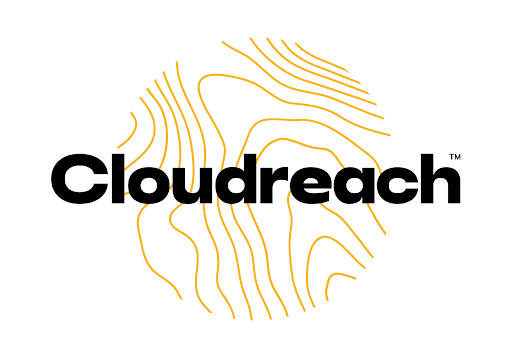
Anti-Marketing
Most technology-oriented marketing campaigns inspire the target audience to use the advertised product or service as much as possible. This statement holds true for most companies looking for customers to download and use their mobile apps. This is also where you can differentiate your campaign to stand out amongst the rest. For example, the newest campaign from the popular dating app, Hinge, inspires it’s the target audience to delete their app. Yes, you read that right. That may sound counterintuitive, however, it guarantees a different approach from their dating site counterparts, who focus on their service being the best at finding love for its users. Hinge’s campaign, instead, inspires its users to find love and delete the app.
Of the campaign, Hinge CMO, Nathan Roth, said “It’s quite common for apps to optimize for time in-app, whether it’s to maximize subscription or advertising revenue. We are purely focused on our users’ success and that’s helping them find someone worth deleting the app for. That’s our single focus,”
Interested in learning more about the zigs and zags of the technology industry? Contact us.
In recent years illustration has evolved far beyond traditional child’s play. The classic art form that many people associate with children’s books actually has serious B2B benefits.
More and more, illustration has become a focus of company web pages, getting more unique and colorful with each year. Illustrations can be a powerful tool in brand storytelling and avoiding the potential pitfall of cheesy stock alternatives. They can provide your customers with an approachable introduction to a brand, while also reinforcing design styles or colors key to your visual identity. For many B2B companies, illustrations have become an essential component of customer-facing imagery.

Here at Bluetext, we see a variety of purposeful illustration styles. Two of the main objectives for B2B companies seeking illustration is to visually describe abstract products, or depict meaningful customer experiences. For many industries, such as tech or cybersecurity, showing literal subjects or end-user experience is not possible through photography, therefore, illustration is an ideal solution.
Below are some of our favorite illustration themes used to take clients’ business goals to new heights.
Flat
There’s no reason to shy away from simplicity! Flat illustrations have been a huge trend in 2020, with many major companies including GoDaddy, Mailchimp, and Slack implementing them into their brand designs. This illustration style is most often used to depict people or experiences. Stock photography tends to favor extremely generic scenarios, or let’s face it, painfully boring subjects. When your business wants to highlight a specific experience or incorporate as much branded detail as possible, custom art may be the way to go. Illustrative styles offer far more flexibility and adaptation, without falling flat.
Bluetext produced flat illustration styles for Centauri’s employee engagement campaigns to depict unique company events and contests that stock photos could not.
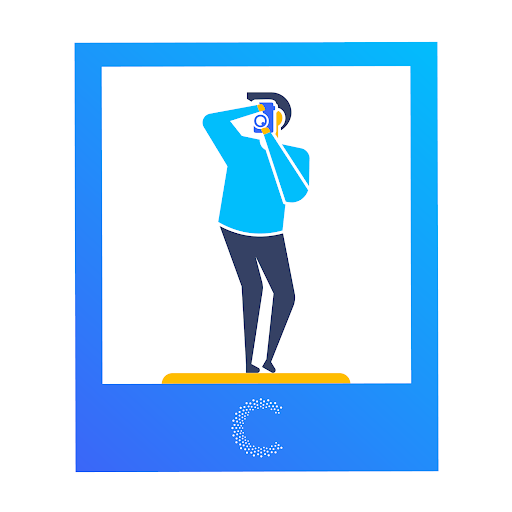


3-Dimensional
Bluetext’s work for Cvent brought custom illustrations to life in a 3D animated video. Intended to immerse the viewer with a preview of the event experience, graphic designers and animators transformed human illustration into a realistic simulation. With this stunning visual design, Cvent was able to digitally communicate their in-person experience to remote viewers and translate their business value in the most powerful manner.



Sketch
Bluetext’s work for GMAC, Graduate Management Admissions Council, promotes graduate school admissions in an approachable and digestible manner. Stretch illustrations were used in the revamped CallingAllOptimists.com campaign to inspire people motivated to improve their future opportunities into action. Juxtaposing a serious life decision and often anxiety heavy admissions process with a uniquely, optimistic brand identity captures both the courage and the celebration of the end-user. Illustrative styles complemented real photography to provide a snapshot of the user, decision factors, and end result.

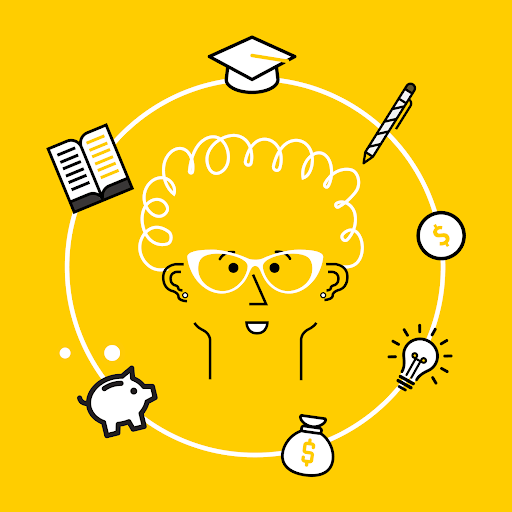
Monochromatic Gradient
In another successful campaign for GMAC, Bluetext designed custom humanistic illustrations to represent user personas. In awareness of a wide breadth of audience targets, the campaign opted to show a variety of potential applicants in a range of career stages. To resonate with a potential applicant, it was key that they could imagine themselves pursuing a graduate degree. To avoid isolating any potential audience members, Bluetext’s custom illustrations avoided biases of race or ethnicity by showing monochromatic styling of men and women in post-grad, young professionals, and even in established careers.
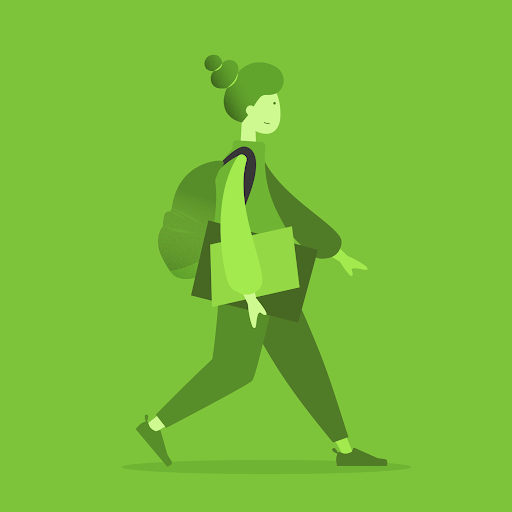

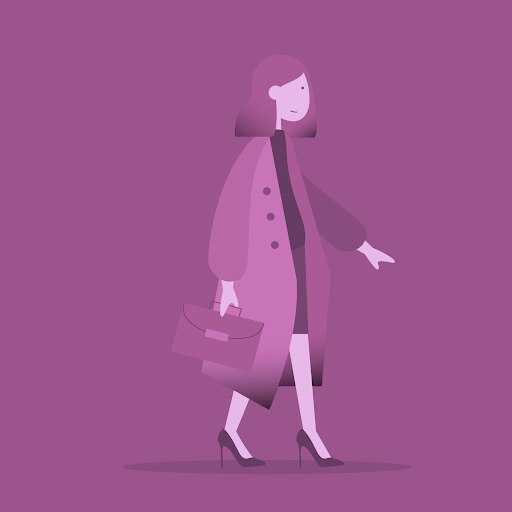
Product Illustration
Another top use case for illustrations is product depictions. Especially in service-based or digital industries, it can be a challenge to accurately depict what you’re selling to customers. Bluetext client RevBits, a cybersecurity software and service provider, overcame this obstacle with branded product illustrations. With a complex product lifecycle, visuals helped conceptualize their cybersecurity offerings in a clean and user-friendly format. Especially on webpages, product illustrations were an ideal way to communicate offerings to users scanning a webpage and without the time or desire to read long paragraphs of text. The illustrations utilized key brand elements such as color palettes and iconography to maintain a consistent brand experience throughout the website.



Digital illustrations are catching a new wave of excitement from companies across all industries. With an ever-expanding range of use cases and applications, we predict this will quickly become one of the most effective ways for B2C or B2B companies to start a more emotional conversation with users. With the rise of personalization and hyper-targeting, establishing warmer and more “human” relationships with clients and customers is a proven way to strengthen loyalty and improve overall ROI.
Interested in exploring the potential of a rebrand (or illustrations!) for your business? Contact Bluetext today.
When building and launching digital campaigns, many of the key determinants of success are evaluated through digital engagement measurement and tracking. However, as websites and ad-tech have evolved in recent years, so have protections and privacy policies. It’s easy to write off the need for a comprehensive privacy policy, however, this is a recipe for disaster in the age of big data regulation and enforcement. To avoid the FTC and International regulators ire, digital agencies such as Bluetext recommend taking data privacy measures that cater to the most comprehensive regulations in effect.
For businesses with users outside of the United States, being aware of the General Data Protection Regulation (GDPR) and similar legislation is an essential consideration. The GDPR has created strict provisions for EU web users’ privacy and data rights, which extends to US browsers. As global privacy legislation evolves, North American businesses that handle global users’ data must comply with current regulations and build with an eye on future compliance. Top digital marketing agencies advise and design campaigns and websites with these policies in mind to provide frictionless engagements.

What is the GDPR?
The GDPR is an extraterritorial set of provisions that updated Europe’s data protection standards. The privacy policy strengthens the protections set in 1995, adding requirements for greater transparency and disclosure to users, in addition to modernizing the “cookie law” of 2002.
The GDPR goes beyond earlier regulation, focusing on personal data protection regardless of the type of data and how companies must document user consent in a transparent fashion. These protections apply to all persons browsing within or originating from the European Union.
The term “personal data” is not synonymous with “personally identifiable information”, or PII. PII has traditionally been a legal concern for American businesses, and it refers to a more defined set of information than the GDPR model. PII does not have to be context-specific to be regulated, in contrast, the GDPR emphasizes the consumer risks of data aggregation.

My business isn’t located in Europe, why should I care?
The GDPR’s reach is far greater than the medley of privacy protections in effect across the United States. Violators of the regulations risk penalties of €20 million ($22.6 million as of writing) or 4 percent of global annual revenues for the preceding fiscal year, whichever is greater. Comprehensive legislation at the state level in the U.S. has been varied, many forward-thinking businesses are beginning to take steps to adapt their practices to comply with the California Consumer Privacy Act (CCPA). Ultimately every website will have to comply with some set of standards, so it is wise to be proactive and implement privacy protection now. Top digital marketing agencies such as Bluetext are taking steps to protect against potential violations of the CCPA and GDPR by changing cookie collection practices, recommending new data collection practices, and designing clear consent forms.

Changing privacy policies impact sites from the bottom up, starting with development and design
In a digital-first world, data is a critical component of many businesses online and offline strategies. With the implementation of the GDPR, marketers and web developers must be more diligent about what data we collect, the means by which we collect it, and how we handle sensitive information. When building or updating websites, web developers, and digital project managers should take this as an opportunity to rethink how sites can be more transparent and adopt the Privacy by Design framework.

The Privacy by Design framework highlights design-thinking approaches to development prior to launch to eliminate the need for post-hoc privacy fixes once a project is live. Solutions such as making privacy the default setting for site visitors, making privacy standards visible and open, and giving users specific privacy information notices are easy considerations to add to the development plan.
If your site is already live, consider a development sprint focused on auditing areas of potential weakness. In assessing your data hygiene, your team can look for unsafe or unnecessary modules that can be disabled, particularly those found in APIs and third-party libraries. Adtech integrations may help source leads and retarget with better precision, but validating that their pixels and tracking are in alignment with GDPR best practices is essential.

The aesthetic design of websites is also impacted by changing privacy practices. GDPR consent requires clear and explicit opt-in notices to users. Designers, user experience experts, and marketers should work collaboratively to update existing landing page components to incorporate new disclosure features. One simple mantra to internalize in the design phase? Offer accessible, clean choices around cookies and pixels.
When building clear user permissions for data capture, the GDPR requires that websites define data retention and deletion plans for all the personal data collected. Adding GDPR conscious logic to scripts at the code level of your site can save time for site custodians and business analysts alike in the future.
Updating best practices for common marketing tactics and tools
Updating the fine print on your Privacy Policy is just the first step of complying with new regulations; common marketing campaign tactics such as cookies should also be rethought through the lens of compliance. Cookies are the small data files that can be placed on users’ browsers and provide a trove of useful insight to website operators. Under the GDPR, businesses are legally liable for any activities on their sites, specifically protecting user data from third-party cookie tracking.

Many businesses use cookie tracking to better measure the impact of their marketing strategies, and they combine tracking with other user data to build user personas. While this has been an accepted practice in the past, the new regulation now requires clear permission from European users to collect this information, whether the site is for an American or French company. As noted in the impact of GDPR on design, cookie usage has to be explained on either the homepage or a second-level page on the navigation. This immediate opt-in should allow users to understand how their data is collected, the purpose of the data, and how long they are consenting to these cookies.
As a website operator, sites must withhold all cookies and trackers on your website until you have received clear and explicit user consent on each type of cookie and tracker. This consent has to be given freely, described in explicit plain language, and users must have the ability to withdraw consent. The rights of users under the GDPR are extensive — to comply, website custodians must update their privacy policies and opt-in tools.
This sounds like a lot of work, why should I care?
Ultimately, thoughtful privacy policies, development, and design provide a safeguard for both businesses and users. The GDPR gives consumers new rights to access and manage their data on digital platforms, and businesses that do not adapt to meet these regulatory requirements can face steep fines. While these changes can seem overwhelming, a top digital marketing agency such as Bluetext can guide your business through the murkiness of data privacy design and compliance.
The recent COVID-19 outbreak has had ripple effects across almost every industry. Around the world, the global pandemic has altered the way we live, socialize and even conduct business. In this unprecedented scenario clouded with uncertainty we all, especially digital marketers, are wondering: What needs to change? And how drastically?
When it comes to search engine optimization strategies, digital marketing and content agencies are continually researching the latest trends and evolving best practices. In the current environment, the role of a top digital marketing agency is to keep a pulse on the present, while also looking forward to strategies that will drive long-term success. Here at Bluetext, our digital marketing analysts are harnessing a variety of tactics to support overall business goals and serve users the best we can during these uncertain times. Check out the top ways we’ve been monitoring and optimizing around current events.
Strength in Numbers
When in doubt, trust the data! Using top marketing analytical tools, such as SEMRush and Moz, one can track the aggregate behavior of online users. Gathering the most up to date data can be tricky, so don’t do it alone. The more expertise and tools, the better. Trust a marketing analytics agency to help break down the numbers into a comprehensible story of website traffic. Use professional tools, such as Google Analytics and Google Search Console, to monitor the recent fluctuations in your page traffic. Do a keyword analysis of your current keyword list to see if search volume has shifted. Google Trends page is a great tool to identify emerging patterns. Are there new phrases your customers are searching for? If the language has evolved, so should your SEO strategy. If you have chatbots for customer service transcripts, these can provide valuable insight into current needs.
In short, the data doesn’t lie. Businesses need to understand search traffic shifts to get as clear as possible a picture into whether to pivot your SEO strategy or not.

Content is King — Still
Ultimately any changes to your SEO strategy should be driven by your unique business needs. For example, a brick and mortar store will need to cater to how they can serve customers at home. If your business was already available online, you may be experiencing altered user behavior as people spend more time at home and online. Every business should ask: “Is the content relevant to current needs?” Your messages may need to shift in sensitivity to the current environment. A complete overhaul is not necessary, nor appropriate. However, if there are opportunities to generate new content that supports your users in a unique time, do so. And if your business is considered essential or has been significantly impacted, you should create a dedicated page to capture all relevant coronavirus traffic. Keep the page simple, focused and sensitive. Don’t try to provide the latest breaking news, but exactly what and how your company is doing. If your business has been minimally affected, perhaps there is an opportunity to contribute to emerging conversations. Exploding Topics is a valuable tool for up-to-date trends across search engines and social media mentions. At the end of the day, users are seeking timely and accurate information now and long after the dust has settled on this pandemic.
 Optimize Often
Optimize Often
Search engine optimization is never a “one and done” task. Any digital marketing strategy requires upkeep as is the nature of the evolving industry. Now, more than ever, flexibility is paramount to staying afloat. Be proactive, be vigilant. SEO strategy will need re-evaluation in the upcoming weeks and months. No one can predict how long the pandemic will last so you must be ready to pivot to any new or resurging customer needs.
In an unpredictable environment, one thing is certain: this is our new (remote) reality. Don’t expect old strategies to work as they once did, and don’t expect this shift to “blow over soon”. Your business should be prepared to remain relevant now more than ever. There will likely be long term implications in behaviors and business operations. Get behind the shifts now and flex your agility. It will pay off in your long term business health.
If you’re looking to partner with an agency to pivot your SEO strategy, let us know.
As of late, communications have been drastically changing, and companies have had to adapt quickly and swiftly to accommodate the current COVID-19 environment. It is a new and unprecedented scenario, forcing flexibility and fast thinking to all aspects of the business. As work-from-home policies and entirely virtual communications surge, recruitment strategies have been greatly impacted. How a company reacts to this digital shift and adapts various business models is crucial to future success following the return to normalcy.
Improving Remote Recruiting & On-Boarding
Learning how to better recruit and virtually onboard, not only during COVID-19 but throughout a company’s entire lifespan, is essential. It demonstrates your company’s ability to stay flexible, proactive, and conform to different comfort levels.

Have a Convincing & Personalized Careers Page
Virtual recruiting isn’t a novel idea. Companies have been trying to actively attract new talent online for years. However, in order to get a great pool of new hires, you need one thing: an outstanding career section on your website. Your career section is the portal for all potential new employees to investigate your company, culture, benefits, growth opportunities, and what you are all about. This is your first impression to prospective employees, who are most likely browsing opportunities at multiple companies! The main mission of a career section is to make the biggest impact in the shortest amount of time. How do you do this? With the proper targeting.
Proper targeting isn’t all about spending large sums of money on paid media. It’s important to utilize your current resources and current employees to create a lasting campaign. Centauri, a technology-driven company providing high-end, creative software and engineering solutions to critical national security missions, came to Bluetext wanting a recruitment-focused campaign. Looking at the diversity in the age, specialty, race, gender and backgrounds of current employees, Bluetext created a range of different personas. Backtracking to Marketing 101, persona creation is a critical step in marketing to the right audience. It’s crucial to know a user’s specific goals, interests, and motivations. For example, a young college graduate student will have different goals versus an experienced middle-aged military veteran. By creating personas, potential employees are able to connect more with someone that closely resembles them. For proper targeting, personalization is key. The career section should play into all personas, create hyper-specific content and show the user relevant jobs pertaining to them. Sound like a lot of legwork? Digital marketing agencies, such as Bluetext, are experienced and proficient in persona creation and targeting strategies.
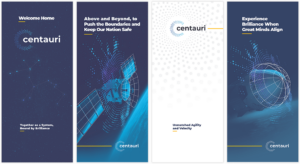
Leverage Alumni Networks
Another great way to better recruit qualified candidates is to create an Alumni Network. This can take many forms, with the most popular being an informal social media group harnessing Facebook or Linkedin). This creates a space for alumni to connect with others, share thoughts, and best of all, provide valuable leads. Not only are you getting free referral lead generation, you nurture an excellent relationship with the company even after the employee has left. It creates brand ambassadors who are constantly promoting your company in a positive light, possible future business partners, and topnotch re-hires.
Institute a Welcoming Virtual Onboarding Process
While virtual recruiting was surging in popularity even before COVID-19, virtual onboarding is relatively new. Companies like Amazon have already begun to virtually onboard thousands of new hires to keep up with higher demands. The biggest concern for most employers is exactly how to bring a newly-hired employee into the company and properly integrate them.
Onboarding is the first time a new employee gets a true first impression of the company in action. Maybe new hires came into the office to interview, but this is the real introduction to the nit and grit of day to day tasks. The first day typically involves numerous face-to-face meetings and handshakes–both no longer possible amidst the COVID pandemic. When virtually onboarding, It’s important to utilize scheduling software, internal communication platforms, and video conferencing tools in order to keep the initial introductory phase as personal, engaged, and genuine as possible. This is especially important for one-on-one meetings with direct managers.

Being able to leverage current new-hire learning processes virtually is a huge focus as well in the current environment. Do your new hires get a “Welcome Binder?” Replace that with a consolidated folder filled with the online version. Do you typically run through various Powerpoints with your new hires? Think about translating those into short, educational shared videos. Are there various informational sessions for new hires? Leverage video conferencing and screen sharing tools. Translating your in-person process to online can be done by almost anyone. In fact, the more people involved the better! Have multiple employees help create onboarding videos so that new hires get introduced to a wider breadth of the company.
The main goal of your virtual onboarding should be to make the new hire feel comfortable. Make sure to over-communicate and offer assistance as much as needed. Be sure they are understanding expectations laid out and asking questions when they feel confused. Make sure they get proper introductions, are included in virtual activities, and let them truly shine.
Virtual recruiting and onboarding are of utmost importance right now, but companies will benefit by taking advantage of these now and implementing these processes for all future recruiting and onboarding processes and the industry shifts. At Bluetext, there is no limit to the amount of success we can help you achieve. To learn more about our processes and to see our work, check out our case studies.
Ready to partner with Bluetext to achieve your marketing goals? Schedule a call with us today.
PR and marketing have changed overnight. There is still a need to reach customers and prospects, but it goes without saying that priorities have shifted in the “new normal” brought on by COVID-19.
It is a challenging tightrope to walk; the news cycle is rightly dominated by the coronavirus pandemic, which means many narratives that resonated pre-coronavirus will struggle to reach your target audiences. For our technology clients selling to government and enterprise decision makers – as well as consumers – we’ve preached several key PR and marketing tenets.
Chief among them is “do no harm.” If we have a client that can offer valuable expertise and insights to advance the conversation and help individuals and organizations navigate the current climate while protecting consumers and businesses, we support those efforts. But you can’t force connections that aren’t there and detract from those better positioned to make a positive impact. In other words, don’t be an opportunist. Don’t be an ambulance chaser. Those efforts will backfire and damage your brand.
Bluetext Digital Briefing Centers
Second, clients and their PR/marketing agencies need to be measured, but also creative and nimble. A government contractor or enterprise software company that relied on physical conferences and in-person sales meetings to engage with customers and prospects must now turn more attention to digital strategies.
Check out how Bluetext has developed Digital Briefing Centers (DBCs) for clients needing a dynamic way to digitally showcase to customers and prospects their full range of solutions in action. Customized presentations, live demos and in-depth discussions can be arranged while offering a proven short-term alternative and long-term complement to physical, face-to-face environments.

PR In the Age of Telework

Businesses can’t just throw up their hands and wait it out; there is still a need for smart PR and marketing to grow or at least sustain sales for the near-term. Digital Briefing Centers address the fact that your website and digital presence is by far now the most important doorway to your brand and brand experience while traditional, physical doors remain closed.
On the PR side, the best way to illustrate how Bluetext thinks when it comes to remaining proactive and creative with clients is through a real-life case study. Transaction Network Services (TNS) is a leading global data services provider with a telecom unit that provides robocall detection technology to U.S. telecom providers. Recognizing that scammers seize on the fear, chaos and confusion caused by health crises, we knew this was an opportunity for TNS to share its important data to help protect consumers from risks to their savings and personal information. Coronavirus scams cost people $7 million in the first 9 days of April alone — so the stakes are high.
Bluetext worked with TNS to rapidly build a strategy to communicate the financial risk to citizens and analyzing data to determine which robocall scams were most prevalent in which parts of the country. Some of the media coverage generated in a two-week period is included below.
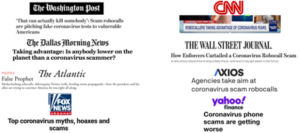
In addition to developing a rapid response strategy, we started to think longer-term about robocall risks in the coming weeks and months. First, we worked with the client to gather data on political robocallers who were capitalizing on confusion regarding postponed Democratic Primary dates in a way that could influence election outcomes – and ensuring the data could be easily visualized.

The bottom line is this: we are in an uncharted phase as a society, and it is a phase that may last for months and even years. The organizations able to adapt to the “new normal” will be those best positioned to support their customers, partners and employees.
If you are looking for a partner to better position yourself to support your customers, reach out to Bluetext.
As the world has changed in the blink of an eye, so has the way we market to consumers. Now, more than ever, your website exists as BY FAR THE MOST IMPORTANT doorway to your brand and your brand experience. While stores stay shut, and face-to-face interaction is vastly limited, brands will rely on reaching their target audiences via their websites. Therefore, your website is mission-critical to your success.
Bluetext has published a 5 part blog series to help you think about and pressure test if your website is the best it can be.
Virtual Executive Briefing Centers are a valuable resource for companies wishing to show customers and prospects their full range of solutions in action, especially new solutions that the partner may not have implemented yet in its own organization. Customized presentations, live demos and in-depth discussions can be arranged. VEBCs offer a lot of great benefits for organizations including:
- Present your brand in a very innovative way with the latest HTML5 and video technologies
- Reach a wider audience, save money and drive efficiencies by reducing travel costs to visit a physical center
- Get your thought leaders delivering their message to a wider audience than their physical weekly calendar allows
- Deliver vertical specific messaging and solutions in a customized fashion
- Personalize the experience based on the understanding of the audiences job title, history with the enterprise, and other components the digital environment can capture and feed into the site
- Juice up your SEO with a smart build and customer journey that enhances your SEO footprint
Bluetext has had a lot of experience designing and developing Virtual Briefing Centers. Here are just a few examples of the innovation we have helped drive for our clients:
McAfee and Intel Security’s Future Agency
McAfee and Intel turned to Bluetext to design a campaign to demonstrate the advancements in cyber security that the companies are driving across the Federal Government. Named The Agency of the Future and found on the web at futureagency.com, the solution integrates an interactive, 3D experience and a series of videos with lead generation integrated throughout. The experience was enhanced with a continuous monitoring webcast that targeted federal IT security experts and drew more than 3000 leads. The campaign won major kudos at McAfee corporate.
CSC’s Digital Briefing Center
CSC’s Digital Briefing Center is where customers, partners and prospects from across the globe can come to learn more about the key technology conversations and market shifts CSC is driving into the market.
The center is driven with immersive 3D video technology that is completely interactive through Html 5 overlays throughout the user journey.
Following launch, Bluetext’s collaborative creation with CSC’s Digital Marketing team became the top performing component of the csc.com global web presence, a huge feat for a Fortune 500 corporation.
Version 2.0 features new capabilities spanning:

-
Multi-floor scalability
-
Triple screen experience
-
Dynamic social media integration
-
Triggered infographic visualizations synched with briefing videos
-
Chaptered video interactivity
The following video of CSC’s head of global brand and digital marketing talks about this project:
TalkShop by Cooper Thomas
From corporate meetings to conferences and workshops, connecting with your workforce and customers is an essential element of business. Bluetext was hired by Cooper Thomas to help enhance their virtual training and meeting services and next-generation virtual platform that can help their customers get the most out of their customers’ virtual events.
With their virtual event platform, you can now connect with employees, customers, and clients conveniently and cost-effectively. The unique speaker-training program guides your presenters to deliver more effective and engaging virtual presentations. The speaker coaches provide focused support to help busy subject matter experts become polished presenters. They also provide project management and program support for events ranging from single training sessions to multi-day conferences, as well as on-site support for virtual and face-to-face events.
As the world has changed in the blink of an eye, so has the way we market to consumers. Now, more than ever, your website exists as BY FAR THE MOST IMPORTANT doorway to your brand and your brand experience. While stores stay shut, and face-to-face interaction is vastly limited, brands will rely on reaching their target audiences via their websites. Therefore, your website is mission-critical to your success.
Bluetext has published a 5 part blog series to help you think about and pressure test if your website is the best it can be.
With 57% of the world’s population now on the internet, promoting your business through a website has become even more critical. Additionally, over 50% of website traffic comes from mobile, and over 66 million American adults now own a smart speaker with digital assistant capabilities. Your website is where a potential customer will get their first impression of your business, and navigating the way website browsing behavior continuously evolves can be tricky. Because having a poorly designed website can be worse for your business than having no website at all, turning toward an expert website design agency can help you find the best website solution for your company. An agency can help you stay on top of the latest web design trends, and bring both your website and your business to the next level.
User experience (UX) is one of the most important things to consider when redesigning your new website. According to Jakob’s law, users spend most of their time on websites other than yours. This means that users prefer for your site to function in a similar manner to other sites they frequently interact with. Staying up-to-date with current web design trends is imperative to keep your users engaged.
Bluetext suggests considering the following seven trends when building your website to ensure that your site combines SEO functionality with the best UX, boosting your brand’s presence online.
1. Make Mobile a Priority
Over 50% of all website traffic comes from mobile. With a user-base continuously becoming more dependent on mobile, it is even more important for website designers to prioritize and optimize web experience for mobile devices. Designers must create a thumb-friendly design to not only make mobile navigation easier for the user but also create a seamless, visually-appealing design.
More than 60% of companies reported an increase in sales after designing mobile responsive platforms; however, approximately 40% of people will leave your website if it isn’t mobile-friendly. While simply having a mobile presence may seem good enough, optimizing this experience through design to cater to mobile users is the most important factor.
If these statistics aren’t convincing enough, it’s also important to keep in mind that Google gives priority to mobile-friendly sites by ranking them higher in search results, positively impacting your SEO. Lacking a mobile-friendly experience can negatively impact your website’s ranking, whereas sites that are mobile responsive will often receive a ranking boost, even for searches on a desktop.
Check out some of Bluetext’s work on mobile with Paya and Mindtree.

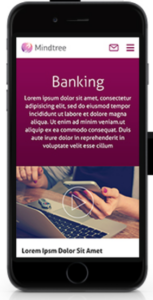
2. Increase Page Speed
It takes users only three seconds to decide whether or not they want to stay on your website. These three seconds are crucial to your website’s dwell time (aka the time a user spends on your website before returning to the search results). Web design agencies can provide creative solutions to help engage your users within these three seconds. Additionally, web agencies know the best tactics for improving page speed, such as image compression. Image formats like JPEG 2000, JPEG XR, and WebP often provide better compression than PNG or JPEG, which means faster downloads and less data consumption.
The less time it takes your website to load, the better your SEO. Because of the Google Speed Update, Google won’t prioritize your website to users if it will take too long to load. Taking your site to a web design agency will ensure that your website is optimized for the user, while also ensuring that you have the best possible SEO ranking.
3. Optimize for Voice Search
Page speed is also becoming more important as the number of smart speakers and digital assistants continues to grow. Over 66 million American adults now have a smart speaker, and designing a website that capitalizes on Voice Search Optimization is the only way to ensure that those using smart devices for their searches will have access to your site. Voice search is meant to be a faster, more convenient way to get information, and if your website takes too long to load, it is less likely to be returned for a voice search result.
According to a PWC study, 71% of respondents would rather use their voice assistant to search for something than manually typing their query into a search engine. The differences between these spoken and typed searches may lead to different SERP results, and if your website is not properly optimized for vocal search, you may lose ground to your competitors. Because vocal searches only result in one top result, everyone is vying for this “ground zero” position. You can obtain this coveted position by gaining Google’s featured snippet spot, which aims to directly answer users’ questions. Voice searchers are also more likely to search in long-form questions as opposed to using shorter keywords, so it’s important to consider the types of questions your target audience may ask, and to position your website well to answer these searches.

4. SEO vs. SEM: Choose Wisely
How can you tell whether to focus your marketing efforts on SEO or SEM? Let’s return to square one: what’s the difference? Search Engine Optimization (SEO) was traditionally thought of as a component of Search Engine Marketing (SEM), which comprised of both paid and organic tactics. However, this language is shifting, with SEM now referring exclusively to paid search. SEO is a method to optimize your website to receive organic traffic, while SEM is a way to funnel in relevant traffic from search engines by buying paid or sponsored ad listings.
So which is better to focus on for your website? SEO allows your business to get more visibility, building brand awareness at a low cost. Choosing keywords that are relevant to your website can earn you a spot on the first page of the SERPs, automatically earning you credibility and trust from search users. In order to increase your website’s chances of making this first page, follow these simple steps:
- Use relevant keywords in the URL to describe the content of the page
- Use your main keywords in the beginning of the title tag of your page
- Use the right keywords in the meta description of your page and make sure it is enticing enough for users to click-through to your site
- Use your primary keyword(s) in the H1 tag of your page
- Use your main keywords along with related long-tail keywords in the first few paragraphs of the page
SEO will bring your website brand visibility at a lower cost, but it’s important to invest in researching which keywords will best optimize your website.
While SEO is typically more sustainable, turning to SEM can also do wonders for your website. SEM allows you to capture the attention of your target audience by claiming a spot above-the-fold of the SERPs. Sponsored listings also give you more control over the results you achieve; every element of the ad can be customized and tweaked to target your audience. SEM charges on a per-click basis, and while this may be more expensive, it allows you to achieve quick, measurable results without going through the trial-and-error process that SEO typically involves.
Both SEO and SEM have their pros and cons, and both may be right for your business at different times. Turning to an agency that specializes in SEO and SEM will help you choose the right tactic at every turn.
5. Hello, Homogenous Hero
The fast pace of modern life means that people have less time to spend on your website. When they enter your site, simple and intuitive web design will allow them to quickly find what they’re looking for. The use of minimal design allows for the rapid digestion of information and ultimately leads to more satisfied users.
The inability to spend endless time searching for information on a website also means that many web design agencies are moving away from the once-popular ubiquitous site, and shifting instead toward the homogenous hero. Instead of boldly featuring the headline in the center of the landing page, designers are opting instead to move the header and CTA to one side, with the image on the opposing side. This split-screen aesthetic also allows for easy conversion to mobile, providing a clear dividing line between the two content blocks.
Check out some of Bluetext’s latest homogenous hero designs through their work with Centauri and Perspecta.


6. Animate Your Site
The use of animation is an easy way to make your website appear polished and dynamic. Animation also helps bring your brand’s story to life, quickly engaging users and drawing more visitors to your homepage. When used as a tool to communicate complex messages easily, animation can reduce the time that a user must spend in order to understand your message, which enables them to spend more time exploring your website.
When adding animation and motion into your website design, it is important to consider web image optimization, which is the process of providing the smallest-sized images optimized in terms of quality, resolution, and format. With the rise of internet browsing on mobile, images and animations must be optimized to perform well on mobile. While animations are a fantastic way to engage your site visitors, they can also slow down your website load times and negatively impact your SEO. Let a professional website design agency like Bluetext help ensure that your website can support lively animation without dragging down your website load time.
When Bluetext redesigned the Clarabridge website, we made sure to incorporate motion in a sophisticated way, making the UX come alive. We used motion throughout the homepage to engage the user and pull them further down the landing page. This design also quickly explains how Clarabridge works and allows a site visitor to visualize how they might best use Clarabridge’s services.


7. Incorporate More Video Content
Video content diversifies your web page, and also appeals to those fast-moving users who do not have the time to search through a lot of text. Videos are also a great way to make an emotional connection to your users and lead to a better overall website experience. By 2020, experts predict that 80% of online traffic will be video. Additionally, 72% of businesses say that video has improved their conversion rate, and 45% of people watch an hour or more of video per day.
While video content is clearly an important marketing tactic, 64% of marketers see video as the most difficult content to create. Not only do videos take time to plan, shoot, and edit, but it is also tough to decide exactly what type of content should be presented in your video. Because viewers’ attention starts to drop off after roughly two minutes, finding an expert who specializes in video content may be the best route for creating the perfect video for your website.
Not only will video content boost your website’s success, but it is also rewarded by Google. If your site includes video, it is 53X more likely to get a first-page spot in search results. Video improves SEO, which boosts your ranking. But if a short video is one of the first impressions a user will have of your business, how do you go about creating successful video content, and keep the user coming back for more? Many website design agencies have video specialists who can tell your story in a clear and powerful way. Check out Bluetext’s latest video work with Invictus.
Invictus Brand Essence Video, July 2019 from Bluetext on Vimeo.
 Optimize Often
Optimize Often